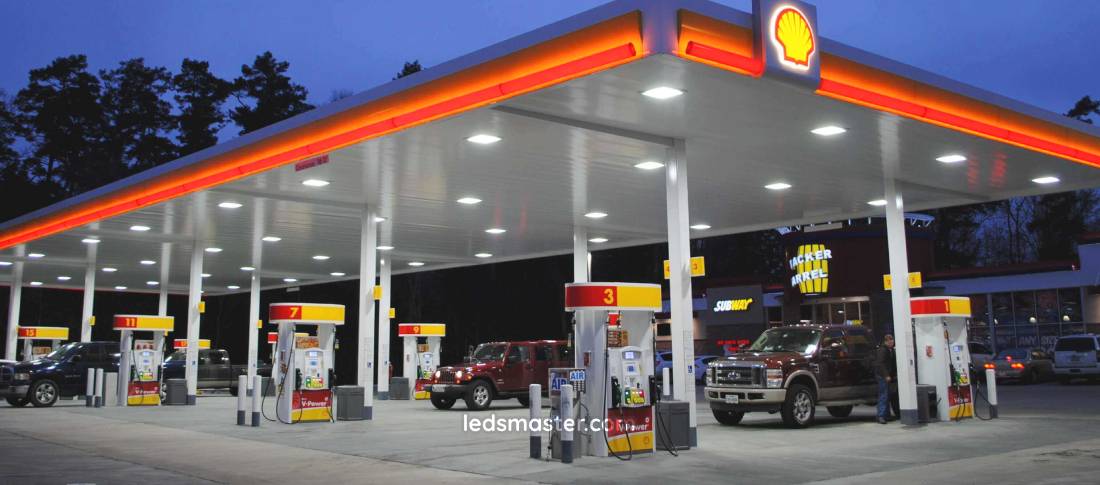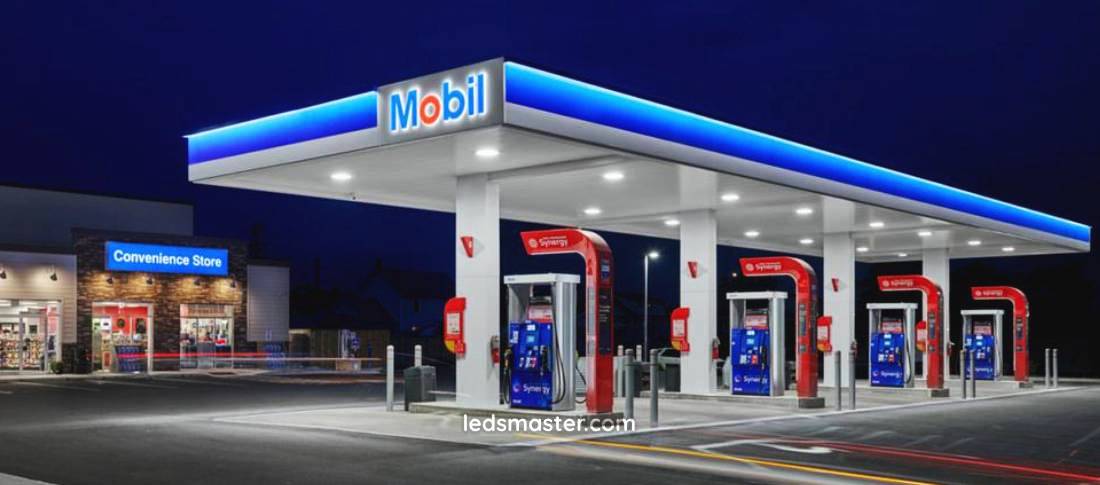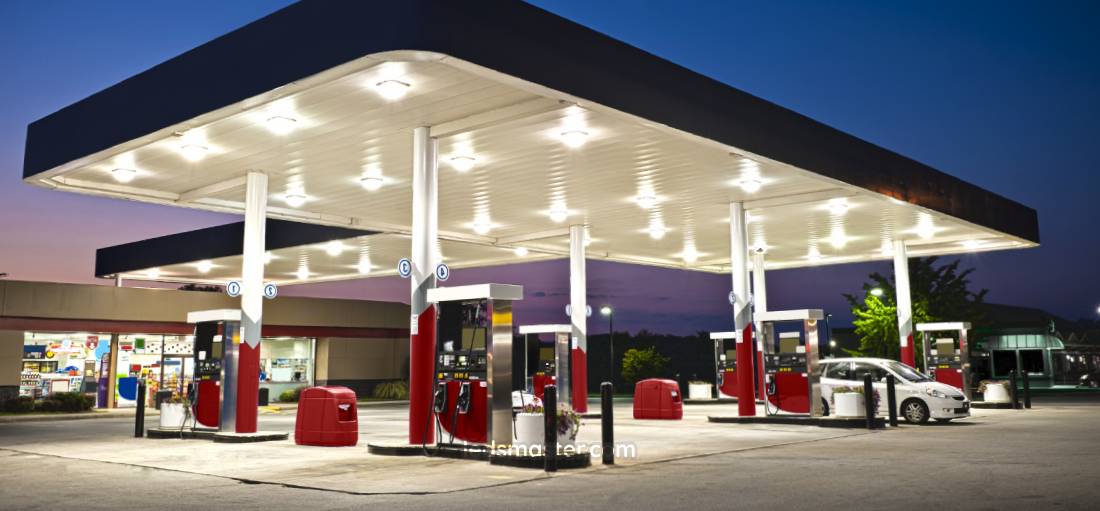The lighting at a gas station does more than just illuminate the space—it shapes the entire customer experience. From guiding drivers to enhancing safety and setting the right mood, the right lighting design affects both practicality and appeal. Understanding how color temperature and lux levels work together is key to creating an effective lighting setup.
Get your complimentary lighting design today
The way a gas station is illuminated can have a direct effect on its operational efficiency and the overall customer experience. Proper lighting design is not just about visibility; it’s about creating an environment that balances functionality with aesthetics. Effective lighting enhances safety, improves security, and sets a tone for the station that attracts customers at all times of the day.
Table of Contents
ToggleA comprehensive lighting design for a gas station involves several key components. Each section of the station needs tailored lighting solutions to ensure safety, security, and a welcoming atmosphere. This includes the forecourt, parking area, convenience store, and surrounding perimeter.
The forecourt is the area where vehicles park for refueling, and it must be well lit to ensure easy navigation. The placement of lights should be focused on providing uniform brightness across the entire fueling area. This is especially important for nighttime refueling, where drivers need clear visibility of the pumps, hoses, and any surrounding hazards.
Light poles are typically used in these areas to provide high levels of illumination and to minimize shadows. The poles should be tall enough to cover a wide radius, yet low enough to avoid blocking the view of drivers. Brightness is measured in lux (lx), with a target range of around 100-150 lux in the forecourt area.

Gas stations often feature parking areas where customers can park their vehicles while they visit the convenience store or use other amenities. In parking areas, safety remains a top concern, as customers should be able to park and walk in and out of the station without difficulty. Lighting must be strategically placed to ensure that each parking space is illuminated while minimizing the creation of dark, unsafe zones.
LED lighting is increasingly becoming the go-to solution for parking lot lighting because of its energy efficiency and longer lifespan. When designing this lighting system, it is also important to factor in the height of poles to ensure even coverage across the entire parking lot.
The convenience store, often attached to the gas station, serves as another focal point for lighting. This space is frequently visited by customers who want to purchase snacks, beverages, or other products. The lighting design here focuses on creating a bright and inviting atmosphere to encourage customers to enter and stay longer.
Inside the store, overhead lights should provide uniform coverage without creating harsh contrasts. Accent lighting can be used to highlight products or special displays, guiding customers’ attention to promotional items or high-demand goods. The design must also consider the balance of natural light from windows and artificial lighting to maintain an inviting, comfortable space.
Different types of lighting fixtures are required for each area of a gas station. The selection of fixtures depends on the location’s purpose, the level of illumination required, and the energy efficiency goals of the station.
LED lighting is the most common type used for gas station lighting due to its energy efficiency and longevity. LEDs offer high luminous efficiency, meaning they can provide more light using less energy. They also have a longer lifespan compared to traditional light sources, which makes them a cost-effective solution for gas stations that are open for extended hours.
LED fixtures are available in various forms, from pole-mounted lights for the forecourt to recessed lights for the convenience store. These fixtures are often designed to provide uniform lighting without glare, making them ideal for all types of gas station applications.
Metal halide lighting was once the standard for outdoor gas station lighting, especially for high-bay applications like the forecourt and parking lot. These lights offer bright, crisp white light, but their energy consumption is higher compared to LEDs. Metal halide lamps are still found in some older gas station designs, though many stations are transitioning to LEDs due to their better efficiency and performance.
Fluorescent lights are typically used indoors in areas like the convenience store. These lights offer good coverage and energy efficiency, although they may not provide the same high-quality lighting as LEDs. Fluorescent lighting can be used in combination with other lighting sources to create the right balance of brightness and ambiance inside the store.

High-pressure sodium (HPS) lights are another option for gas station lighting, commonly used in older designs or areas where extreme durability is needed. HPS lights produce a warm yellow light, which may not always be ideal for a modern aesthetic but can be effective for providing a general level of illumination in outdoor spaces.
The choice of color temperature and lux levels plays a significant role in the functionality and atmosphere of a gas station. These two factors affect not only the visibility but also the overall customer experience, influencing how safe, inviting, and comfortable the space feels. By understanding how different lighting temperatures and lux levels impact different areas of the gas station, operators can create an effective and appealing lighting design.
Color temperature refers to the warmth or coolness of light, measured in Kelvins (K). It is an important consideration because it sets the mood and tone of the space. Different areas of a gas station require varying color temperatures to provide the best lighting for their specific purpose.
Often used for outdoor spaces like the forecourt and parking lot, cool white light creates a bright, vibrant atmosphere. This is especially useful for areas where high visibility is necessary, such as fueling stations, to ensure customers and staff can clearly see and navigate. It is also preferred in areas where security is a concern, as it minimizes shadows.
This range of color temperature is commonly used in convenience store areas. It provides a balanced level of brightness without being too harsh or too warm, making it ideal for general areas where customers might spend more time, such as aisles or checkout counters. Neutral white light enhances product visibility and creates an inviting environment.
Warm light creates a more relaxed and inviting ambiance. It can be used in less utilitarian spaces like the interior of a convenience store or in customer seating areas. It evokes a sense of comfort and is well-suited for spaces where customers might linger for longer periods.
Lux is the unit of measurement for illuminance, indicating the amount of light falling on a surface. Different areas of a gas station require different lux levels to ensure proper illumination. Setting the right lux level helps prevent accidents, supports customer satisfaction, and enhances the overall effectiveness of the lighting design.
| Area | Recommended Lux Level | Purpose |
|---|---|---|
| Forecourt | 100–150 lux | Provides sufficient brightness for refueling areas. |
| Parking Area | 30–50 lux | Ensures safe navigation for customers parking their vehicles. |
| Convenience Store | 300–500 lux | Helps customers see products clearly and comfortably. |
| Perimeter/Surrounding Areas | 20–30 lux | Provides minimal illumination to ensure security without light pollution. |
The combination of appropriate color temperature and lux levels directly impacts the safety and security of a gas station. For example, cool white lighting in the forecourt can help drivers see fuel pumps and navigate safely around the station, reducing the risk of accidents. Similarly, ensuring that the parking lot is illuminated with the right lux level can help reduce potential safety hazards and increase the visibility of customers walking to and from the store.
The right balance of color temperature and lux levels also supports security by eliminating dark spots where criminal activity could go unnoticed. Lighting at the correct lux level and color temperature can deter unwanted activity, making the gas station feel safer for both customers and staff.
With growing concerns over energy consumption and environmental impact, gas station lighting design has increasingly focused on energy-efficient solutions. Energy-efficient lighting reduces operational costs and lowers the station’s carbon footprint, which is an important factor in both reducing expenses and meeting sustainability goals.

One innovative solution for reducing energy consumption is the use of solar-powered lighting. Solar panels can be installed on roofs or other structures to power outdoor lighting, particularly in areas like the forecourt or parking lot. This reduces the need for traditional grid-based power, saving on electricity costs and contributing to a more sustainable operation.
Smart lighting systems are also gaining popularity in gas station designs. These systems use sensors to adjust the lighting based on factors such as time of day, weather conditions, and the amount of activity in different areas of the station. For example, motion sensors can detect when a car pulls into the forecourt, automatically adjusting the light levels to provide optimal visibility. Smart systems also allow for centralized control, which can simplify maintenance and scheduling, ensuring lights are only on when needed.
Gas station lighting is not only functional but can also be an important part of a station’s branding. The lighting design can help create a particular atmosphere, enhance the station’s visibility, and differentiate it from competitors. A station with a well-designed lighting scheme will be more appealing to customers, who may associate it with a high level of service and modernity.
The color temperature of lighting can play a role in shaping a gas station’s image. Cooler white lighting can evoke a clean, modern feel, while warmer lighting can create a more inviting atmosphere. Gas stations can tailor their lighting design to reflect their brand identity and appeal to their target demographic.
Lighting is also used to illuminate signage, logos, and other branding elements at the gas station. This includes both the signage on the station’s exterior and in-store displays. Effective illumination ensures that customers can easily spot the station from a distance, even at night. It also helps enhance the overall aesthetic of the station, making it visually appealing and easy to identify from the roadside.
Gas station lighting design encompasses more than just illuminating a space for functional purposes. It plays a role in creating a safe and welcoming environment for customers while also contributing to energy efficiency and sustainability. With a mix of different lighting types, careful placement, and consideration of energy-saving technologies, a well-designed lighting system can enhance the experience for customers and improve the operational efficiency of the gas station.
By addressing both the technical and aesthetic aspects of lighting design, gas stations can ensure their operations run smoothly, attract more customers, and build a strong brand presence in the competitive retail fuel market.